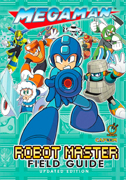
A Critical Look at Mega Man Stages: The Big Guys
As the damage sponge of Mega Man‘s roster, Big Eyes filled a memorable role in the first game. They’re tough to take down, tough to avoid, and will happily stomp new players into a corner when given the chance. Some variation of them appears in each game so far, and their use in the stages is worth reviewing in greater detail.




This is our standard encounter: The player climbs up to a new screen, finds one of these guys, and has to quickly get up the ladder and deal with it. While there are a couple cases in which luring it off an edge is possible, taking too long to kill or bypass it generally ends with it hopping on top of the ladder until the player leaves to try again, or uses an upward-hitting special weapon. This is a common setup for good reason, as it gives players just starting the game a safe place to observe them without being able to kill them, and gives players further along an excellent opportunity to use the weapons they’ve picked up.
It’s also common to see them start on a higher platform, which gives the enemy an initial jump that makes them more intimidating and harder to reach. When moved closer to the ladder, the higher ground will also get in the way when attempting to run underneath. In the cases with a ladder leading upward out of the room, Mega Man 5 and 6 make escape even tougher by allowing their versions to move faster and higher.


Some of the more unique variations of this approach involve the good ladder use seen previously, giving the opportunity to bypass one and attack another through the wall. The ladder maze in Mega Man 4‘s first Dr. Cossack stage also gives us a preview of this Jumbig, allowing players to prepare for it. Mega Man 5 also used a nasty spike pit to force players to fight from the wall or get creative with the items.




Approaching from above is much more dangerous. Sometimes we’re offered a ladder, but in most cases the player will fall in and have only one chance to deal with it before it reaches the wall. Enemies that start lower than the player are in a good position, both partially out of reach and more difficult to dodge under. This Power Slam from Mega Man 6 had a room with more unique terrain that got in the way of both sliding and Jet Mega Man use.
The Power Musclers here had two neat changes to the formula that worked in the player’s favor, with the first being unable to reach the upper ledge, and the second blocked from knocking Mega Man off the ladder, giving us a particularly fun use of Napalm Man’s weapon.


Sometimes we simply meet one while walking down a straight path, which gives us a chance to retreat but may not be as safe as coming from below, depending on what’s behind us. While the first game uses this to great effect to make the first Wily stage imposing, there are many instances where we encounter one on a flat surface this way, particularly in Mega Man 4.


Things get more interesting when we have a narrow hallway to duck into, or staggered terrain. The Sniper Armors from Quick Man’s stage are some of the toughest to fight, both for their positions and proximity to each other.


The Power Muscler from Napalm Man’s stage gets both complex terrain and the potential to spawn behind players that hesitate on the next jump. Two other stand-out moments are the chance to lure one into a hole, and fighting this Power Slam from a safe doorway.


Mega Man 2 provided alternatives to encountering these that unfortunately went unused afterward, with long jumps across small blocks while Sniper Armors wait below, and a wall-length ladder to fight from. The one we can run under here is neat not only for that, but because we need to use the other side of its platform to continue upward, encouraging us to lead it away from the edge first or even use an item to avoid going near it.
While the series handled the basic use of these enemies well, it’s a shame that the first two games gave us some of the toughest fights with them, and that the series didn’t continue designing entire stage segments around them. While other larger enemies started taking their place, it would have been nice to see more with their own platforms, or used as punishment for a fall, or even mixed with other enemies. Mega Man 4 was particularly bad about placing them by themselves on flat ground, while Mega Man 5 gave much better variety in their positioning.
As for their behavior, the jump trick on the original Big Eye (jump before it does to force a high jump) was a great idea, but most players were unlikely to discover it on their first attempt. I liked that Mega Man 3 found a way to avoid asking players to mash at them by giving them a shield, while the added complexity to their movement in Mega Man 5 made moving under them technically easier than most, but scarier to deal with initially. Mega Man 6 tried to do the same, but made them easier to run into when standing nearby. Comparing these to the Sniper Armor is hardly fair, with its ability to shoot and drop a completely different enemy on death, but I’ll go on record saying I love those guys anyway.
Prev/Next in Category(s)
Prev/Next by Date





Comments